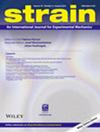测量来自高分辨率晶粒尺度应变场的代表性体积元素
IF 2.4
3区 材料科学
Q2 MATERIALS SCIENCE, CHARACTERIZATION & TESTING
引用次数: 0
摘要
大多数晶体材料在微观尺度上表现出高度不均匀的响应,这可能受到内部因素(如微观结构参数)和外部因素(如负载)的影响。将微观尺度的不均匀性与材料的宏观尺度响应联系起来需要使用均匀化技术,通常基于代表性体积元素(RVE)的概念——代表全球平均响应的最小体积材料。在这项工作中,我们提出了一种新的、稳健的实验方法,从使用数字图像相关(DIC)获得的高分辨率晶粒尺度应变场中测量基于应变的RVE的大小。所提出的方法基于RVE的统计学(体视学)性质,该性质已在数值研究中广泛采用,包括将应变场划分为随机选择的不同大小的区域,并统计分析其中平均应变的分布。为了验证新方法,我们从分数高斯噪声算法中生成了大量的合成应变场。所提出的体视学方法被证明能够从很大范围的可能微尺度应变场中产生可靠的RVE测量结果,同时具有鲁棒性,因为即使在其他现有方法可能无法做到这一点的情况下,它也可以产生RVE测量结果,只需要一个大约是RVE 1.2倍大的视场就可以进行可靠的测量。此外,体视学方法提供了显著的灵活性,因为其统计性质允许控制在每种情况下RVE测量的严格程度。本文章由计算机程序翻译,如有差异,请以英文原文为准。
Measuring representative volume elements from high‐resolution grain‐scale strain fields
Most crystalline materials present a highly heterogeneous response at the microscale, which can be affected by both internal factors (such as microstructural parameters) and external factors (such as loading). Relating microscale inhomogeneities to the macroscale response of a material requires the use of homogenisation techniques, usually based on the concept of a representative volume element (RVE)—the smallest volume of material that represents the global average response. In this work, we present a new and robust experimental method of measuring the size of a strain‐based RVE from high‐resolution grain‐scale strain fields obtained using digital image correlation (DIC). The proposed method is based on the statistical (stereological) nature of the RVE, which has been widely adopted in numerical studies, and involves dividing a strain field into randomly selected regions of varying sizes and statistically analysing the distributions of average strains within them. To validate the new method, we generate a large number of synthetic strain fields from a fractional Gaussian noise algorithm. The proposed stereological method is shown to be capable of producing reliable RVE measurements from a very large range of possible microscale strain fields while at the same time being robust in that it can produce RVE measurement results even in cases where other existing methods may be unable to do so. The proposed method has a low field‐of‐view requirement, only needing a field‐of‐view about 1.2 times as large as the RVE to produce reliable measurements. In addition, the stereological method offers significant flexibility since its statistical nature allows for control over how strict the RVE measurement should be in each case.
求助全文
通过发布文献求助,成功后即可免费获取论文全文。
去求助
来源期刊

Strain
工程技术-材料科学:表征与测试
CiteScore
4.10
自引率
4.80%
发文量
27
期刊介绍:
Strain is an international journal that contains contributions from leading-edge research on the measurement of the mechanical behaviour of structures and systems. Strain only accepts contributions with sufficient novelty in the design, implementation, and/or validation of experimental methodologies to characterize materials, structures, and systems; i.e. contributions that are limited to the application of established methodologies are outside of the scope of the journal. The journal includes papers from all engineering disciplines that deal with material behaviour and degradation under load, structural design and measurement techniques. Although the thrust of the journal is experimental, numerical simulations and validation are included in the coverage.
Strain welcomes papers that deal with novel work in the following areas:
experimental techniques
non-destructive evaluation techniques
numerical analysis, simulation and validation
residual stress measurement techniques
design of composite structures and components
impact behaviour of materials and structures
signal and image processing
transducer and sensor design
structural health monitoring
biomechanics
extreme environment
micro- and nano-scale testing method.
 求助内容:
求助内容: 应助结果提醒方式:
应助结果提醒方式:


